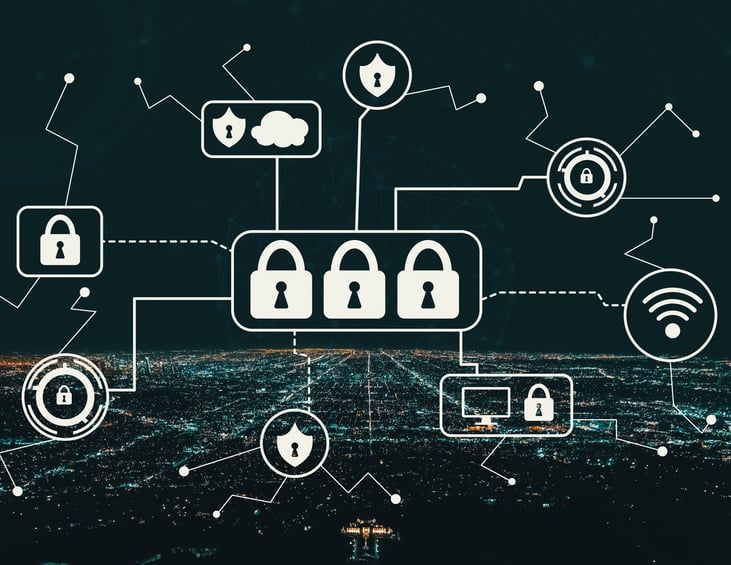Contents
People concern security
Security is an issue that many people using wireless communication are concerned about. There is a definite inborn security issue of wireless communication. For instance, it is easy to eavesdrop on radio waves, so the data carried on the radio waves must be encrypted to avoid security issues. Let's focus on encryptions in Wi-Fi, LTE, and P25 standards.

Encryptions in Wi-Fi, LTE, and P25 standards
・Wi-Fi standard
Wi-Fi Alliance (www.Wi-Fi.org) was organized in 1999 and has published Wi-Fi standards. The alliance has been improving security standards, WEP (Wired Equivalent Privacy), WPA (Wi-Fi Protected Access), WPA2, and WPA3. WAP and WAP2, commonly used, have two modes, PSK (Pre-Shared Key) and EAP (Extensible Authentication Protocol). WPA3 has resembled mode, also. PSK may be for home and small teams and share the same security keys. PSK is relatively weak for cracking. EAP may be for company usage because EAP requires certificates for clients and an authentication server. EAP is relatively strong for cracking but has a high maintenance cost. WPA encryption algorithm is AES (Advanced Encryption Standard) in most cases.
Wi-Fi security
| # | Security | Year | Encryption |
| 1 | WEP | 1997 | RC4 |
| 2 | WPA | 2002 | RC4, AES |
| 3 | WPA2 | 2004 | RC4, AES |
| 4 | WPA3 | 2018 | AES (CNSA) |
RC4: a stream cipher. simple and lightweight, but RC4 vulnerability has been discovered.
CNSA: Commercial National Security Algorithm Suite, including AES for confidentiality, established by U.S. National Security Agency.
・LTE standard
3GPP (Third Generation Partnership Project, www.3gpp.org ) was organized in 1998 and has published mobile telecommunication standards, including LTE/LTE-advance. LTE security standards are finalized at 3GPP Release 8. The standards are based on Key management protocol (3GPP AKA: Authentication and Key Agreement). User and control channels are encrypted with AES. The encryption keys are generated using materials stored in USIM and authentication servers. LTE encryption algorithms are AES, SNOW 3G, and ZUC. In many cases, the AES is the main, and SNOW 3G and ZUC are backup encryptions. Note, the selection of the encryption algorithm depends on your LTE system capability.
3GPP Encryption / Integrity Algorithm May 2009
| # | EEA/EIA | Algorithm | memo |
| 1 | 128-EEA1 and 128-EIA1 | SNOW 3G | Streaming cipher |
| 2 | 128-EEA2 and 128-EIA2 | AES | Block cipher |
| 3 | 128-EEA3and 128-EIA3 | ZUC | LFSR (Linear Feedback Shift Register) Streaming cipher |
EEA: Evolved packet system Encryption Algorithm
EIA: Evolved packet system Integrity Algorithm
・P25 standard
Project 25 (P25, www.project25.org) was organized in 1989. Since then, P25 has developed a suite of standards for interoperable digital two-way radio products for professional businesses, such as public safety, security, public service, and commercial. People know the P25 radio as a walky-talky, push-to-talk radio. The encryption algorithms of P25 are DES (Data Encryption Standard), RC4, and AES. DES and RC4 algorithms are vulnerable to cracking, so AES is a safe encryption option.
The advantages of LTE system
AES is a reliable encryption algorithm. The U.S. NIST (National Institute of Standards and Technology) published AES in 2001. It looks a little bit old, but so far AES is strong enough. Additionally, LTE standards have backup encryptions. Wi-Fi has so many security options that the IT maintenance team may have a hard time keeping up. LTE has a solid security protocol. Also, it is simple and has less maintenance cost. These two points are significant advantages for the LTE system.

For further information, please check out our other blogs and use cases. If you have any questions, please do not hesitate to contact us.












